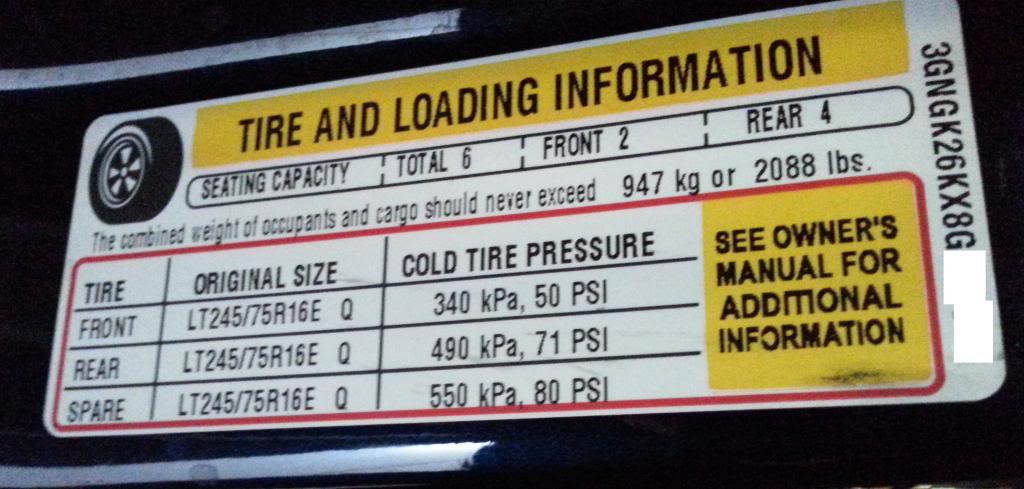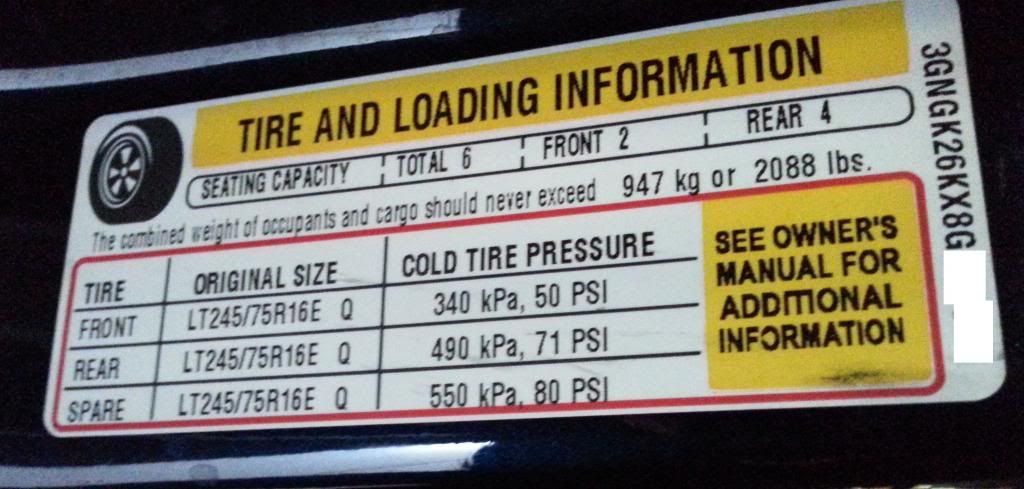Considering all-terrain tires
#1
Hi all,
I'm considering purchasing some all terrain tires. These in particular:
http://www.tirerack.com/tires/tires....omCompare1=yes
I've never had a set of all-terrain tires, and from what I have been reading these tires may require more air than the recommended pressures found in the door jamb. For those of you running light truck/all-terrain tires, how do you find the perfect pressure?
Thanks!
I'm considering purchasing some all terrain tires. These in particular:
http://www.tirerack.com/tires/tires....omCompare1=yes
I've never had a set of all-terrain tires, and from what I have been reading these tires may require more air than the recommended pressures found in the door jamb. For those of you running light truck/all-terrain tires, how do you find the perfect pressure?
Thanks!
#3
The only time I deviate from the pressure on the door tag is when I'm towing with my half ton. It has E-load LT tires, and I air them up to 45 with my 3500-lb trailer, and 65 PSI with my 6500-lb trailer. Seemed to firm things up a bit, made the trailer a little more stable.
On my 3/4-ton Burb, they're always inflated to the door tag numbers, 50 front and 71 back, towing or not.
On my 3/4-ton Burb, they're always inflated to the door tag numbers, 50 front and 71 back, towing or not.
#4
What do you mean by "sub" ?
Wow, I didn't know recommended tire pressures from the manufacturer went that high in regards to your 3/4 ton suburban.
The only time I deviate from the pressure on the door tag is when I'm towing with my half ton. It has E-load LT tires, and I air them up to 45 with my 3500-lb trailer, and 65 PSI with my 6500-lb trailer. Seemed to firm things up a bit, made the trailer a little more stable.
On my 3/4-ton Burb, they're always inflated to the door tag numbers, 50 front and 71 back, towing or not.
On my 3/4-ton Burb, they're always inflated to the door tag numbers, 50 front and 71 back, towing or not.
#5
#6
Super Moderator
I suggest that you choose a pressure that is within 10% of that number for year round use, and here's why...
1) Well/higher Inflated tires usually get better gas mileage.
2) Handling/control (cornering) is greatly improved.
When having to corner hard, higher pressure doesn't allow the tire to skew out of alignment with the Rim, and better supports the additional weight of the Vehicle when that load is majorilly transferred to two wheels instead of all four. Keep in mind that our rides often exceed 6000 lbs when loaded
3) When having to do Hard Breaking, the Tire resists compression keeping the Tread flatter, subsequently has better traction and the ability to stop your vehicle.
4) When encountering a Road Hazard (curb/chughole) higher pressure again resist compression of the Sidewall, limiting the injury to the Tire.
5) When Sidewalls don't flex as much as with lower pressures, Tires run cooler and have a vastly lower failure rate.
6) At High Speed, higher pressure enhances the overall rotational stability/roundness of the Tire, which improves its balance, creating more consistent contact with the Road Surface.
7) Tread Depth Patterns are set up, where over the life of the Tire, that they wear more evenly, when the Tire is inflated in its higher range of pressure.
8) When Towing, or carrying heavier loads (multiple passengers or cargo) the Load Rating of the Tire cannot be assured, unless the Tire is aired up at or near its Maximum Cold Inflation Pressure.
9) Increased pressure maintains the footprint of the Tire, stabilizing the separation of the spacing of the Tread Grooves, allowing it to discharge Water better, on wet surfaces.
#7
Trending Topics
#8
All tires have a "MCIP" (maximum cold inflation pressure) which is stamped on the sidewall of any tire which is sold for USA vehicles. It is as stated, is the maximum pressure you should use, AND, the Manufacturers guarantee that, that pressure can be consistently used in the Tire for it's life. For the Tires you have selected, that pressure is 65 lbs.
I suggest that you choose a pressure that is within 10% of that number for year round use, and here's why...
1) Well/higher Inflated tires usually get better gas mileage.
2) Handling/control (cornering) is greatly improved.
When having to corner hard, higher pressure doesn't allow the tire to skew out of alignment with the Rim, and better supports the additional weight of the Vehicle when that load is majorilly transferred to two wheels instead of all four. Keep in mind that our rides often exceed 6000 lbs when loaded
3) When having to do Hard Breaking, the Tire resists compression keeping the Tread flatter, subsequently has better traction and the ability to stop your vehicle.
4) When encountering a Road Hazard (curb/chughole) higher pressure again resist compression of the Sidewall, limiting the injury to the Tire.
5) When Sidewalls don't flex as much as with lower pressures, Tires run cooler and have a vastly lower failure rate.
6) At High Speed, higher pressure enhances the overall rotational stability/roundness of the Tire, which improves its balance, creating more consistent contact with the Road Surface.
7) Tread Depth Patterns are set up, where over the life of the Tire, that they wear more evenly, when the Tire is inflated in its higher range of pressure.
8) When Towing, or carrying heavier loads (multiple passengers or cargo) the Load Rating of the Tire cannot be assured, unless the Tire is aired up at or near its Maximum Cold Inflation Pressure.
9) Increased pressure maintains the footprint of the Tire, stabilizing the separation of the spacing of the Tread Grooves, allowing it to discharge Water better, on wet surfaces.
I suggest that you choose a pressure that is within 10% of that number for year round use, and here's why...
1) Well/higher Inflated tires usually get better gas mileage.
2) Handling/control (cornering) is greatly improved.
When having to corner hard, higher pressure doesn't allow the tire to skew out of alignment with the Rim, and better supports the additional weight of the Vehicle when that load is majorilly transferred to two wheels instead of all four. Keep in mind that our rides often exceed 6000 lbs when loaded
3) When having to do Hard Breaking, the Tire resists compression keeping the Tread flatter, subsequently has better traction and the ability to stop your vehicle.
4) When encountering a Road Hazard (curb/chughole) higher pressure again resist compression of the Sidewall, limiting the injury to the Tire.
5) When Sidewalls don't flex as much as with lower pressures, Tires run cooler and have a vastly lower failure rate.
6) At High Speed, higher pressure enhances the overall rotational stability/roundness of the Tire, which improves its balance, creating more consistent contact with the Road Surface.
7) Tread Depth Patterns are set up, where over the life of the Tire, that they wear more evenly, when the Tire is inflated in its higher range of pressure.
8) When Towing, or carrying heavier loads (multiple passengers or cargo) the Load Rating of the Tire cannot be assured, unless the Tire is aired up at or near its Maximum Cold Inflation Pressure.
9) Increased pressure maintains the footprint of the Tire, stabilizing the separation of the spacing of the Tread Grooves, allowing it to discharge Water better, on wet surfaces.
#10
Super Moderator
There's two things I'll add to that...
The "door" pressure is generally accepted for the OEM tires, and
The reduction (10%) is offered, only because (analog) Air Gauges have a reputation for inaccuracy. I'm a stickler for abiding by Mfgr Recommendations, and that is in order not to exceed the MCIP. However, if you have a Digital Air Gauge, or for either have verified the accuracy of reading, you can come up to 99.9 % of MCIP. I personally just reduce the MCIP by 2 lbs.
Most of the inaccuracy of Air Gauges is from Debris, which is injected into them, from not having a Cap on the Air Stem, or just not checking for dirt before you add air. When airing my Tires, even though I have Caps on the Stems, I always use the little post on the Gauge to pop a short blast of air out, just to make sure it's clear of debris.
PS Typerod,
Try to do a mileage check, and let us know if there is a substantial increase.
The "door" pressure is generally accepted for the OEM tires, and
The reduction (10%) is offered, only because (analog) Air Gauges have a reputation for inaccuracy. I'm a stickler for abiding by Mfgr Recommendations, and that is in order not to exceed the MCIP. However, if you have a Digital Air Gauge, or for either have verified the accuracy of reading, you can come up to 99.9 % of MCIP. I personally just reduce the MCIP by 2 lbs.
Most of the inaccuracy of Air Gauges is from Debris, which is injected into them, from not having a Cap on the Air Stem, or just not checking for dirt before you add air. When airing my Tires, even though I have Caps on the Stems, I always use the little post on the Gauge to pop a short blast of air out, just to make sure it's clear of debris.
PS Typerod,
Try to do a mileage check, and let us know if there is a substantial increase.
Last edited by SWHouston; September 16th, 2015 at 11:09 AM.




